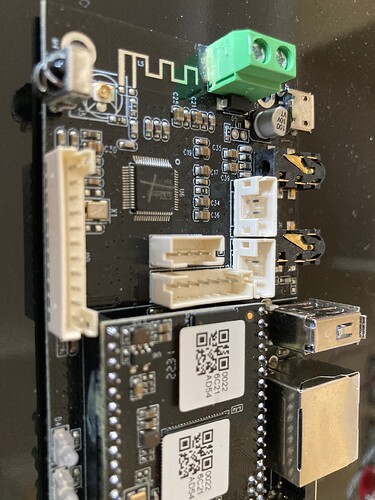The convenience and streaming sound quality from Sonos Wi-Fi speakers have convinced me to have converted all my CD music collection to FLAC files. But current Sonos speakers support music files in Windows media library up to only 16-bit/44.1kHz FLAC, and don’t support FLAC format at all on local NAS. These are big drawbacks for me to move forward more digitally.
I ordered Arylic Up2Stream Pro V3 boards with goals to 1) upgrade all my legacy audio receivers to Wi-Fi streaming capability and be on a term with multi-room audio path; 2) additionally built my own Wi-Fi streaming floor-stand speakers.
The Up2Stream Pro V3 boards had a compact design layout, and were manufactured with high-quality components and PCB process. 3.5mm phone jacks for audio in and out were gold plated, so were the USB and Ethernet ports of course. The 5V power connector were adhered to the PCB prior to soldering, strengthened it for screw wire tightening - I only hope other manufactures could do the same. In-line connectors pin-outs were labeled on the under-side of the PCB, a very good practice. The board is packaged in a good quality clear nylon case, making it stand out from other brands of component boards - kind of like iPhone vs. all cellular phones before it. User Manual is provided on a trimmed downsize sheet. I wish the letters be enlarged 2X, as quite often I have to search for my magnifier to read the finest prints. On-line PDF format, unfortunately were cut to the same print format size, not helpful. The on-line PDF should at least provide a larger format print option. The content of the User Manual is brief but important. A thorough reading of the User Manual would gain you necessary understanding of the board.
Fig. 1: Power Connecter Build Quality
Fig. 2: Backside of PCB, good practice of connector pin-outs labeling.
The Wi-Fi operation relies on a mobile app 4Stream. The Wi-Fi connection supports 2.4GHz technology only, so on the first setting up, making sure your mobile device used is on a 2.4G band. Once connection established, your mobile device can be on either 2.4G or 5G band to control the App operations.
On board, Mountain View DSP chip is used, which has an A/D section supports up to 24-bit / 192k music streaming in, and four D/A converters for up to 16-bit / 48k music out. Although not 24-bit / 192k level audio output, this is an important “upgrade” from Sonos speakers and is on-par with the popular Analog Devices ADAU1701 performance. The “hi-res” music files in my collection finally can be digitally streamed and processed.
I haven’t had a chance to connect, but I2S pins are provided on board for off-board DAC or I2S Amp. The sound quality from this streaming board as is, is satisfying relative to generic CD player, or Bluetooth streaming. The biggest value of this board is its multi-room synchronized audio capability, which applies to floor-stand 4-way speaker build as well.
The Pro V3 board has two siblings. The simplified version saved from not having audio in, USB in, and Ethernet connectivity, I2S output is retained so audio quality upgrade path is still there, and this can be a better choice for speaker build. The more elaborated version includes optical/digital port and an upgraded DAC, which can be a better choice for a streaming amp build. Both will be tested in the near future.
A side note. I have two of the Pro V3 board, the first board went through setup smoothly without issue, but my second board had trouble connecting to Wi-Fi. At first I thought I had a defective unit, as the audio through Bluetooth is functioning. It turns out that a subpar 5V power supply is at fault, not the board. The board is measured to consume around 250mA of current, and at that rate some of the off-brand 5V battery chargers drop to <4V. So make sure a good quality 5V power source is used.
Fig. 3: My DIY preamp testing platform, using Arylic Up2Stream Pro V3 board (in the back corner) as music streamer. This is to upgrade legacy Audio/Video Receivers of different brands around the house to multi-room play.
Fig. 4: Arylic Up2Stream Pro V3 used in my floor-stand 4-way speaker build.
Fig. 5: 4-way speaker build under testing on an experimental platform box.




